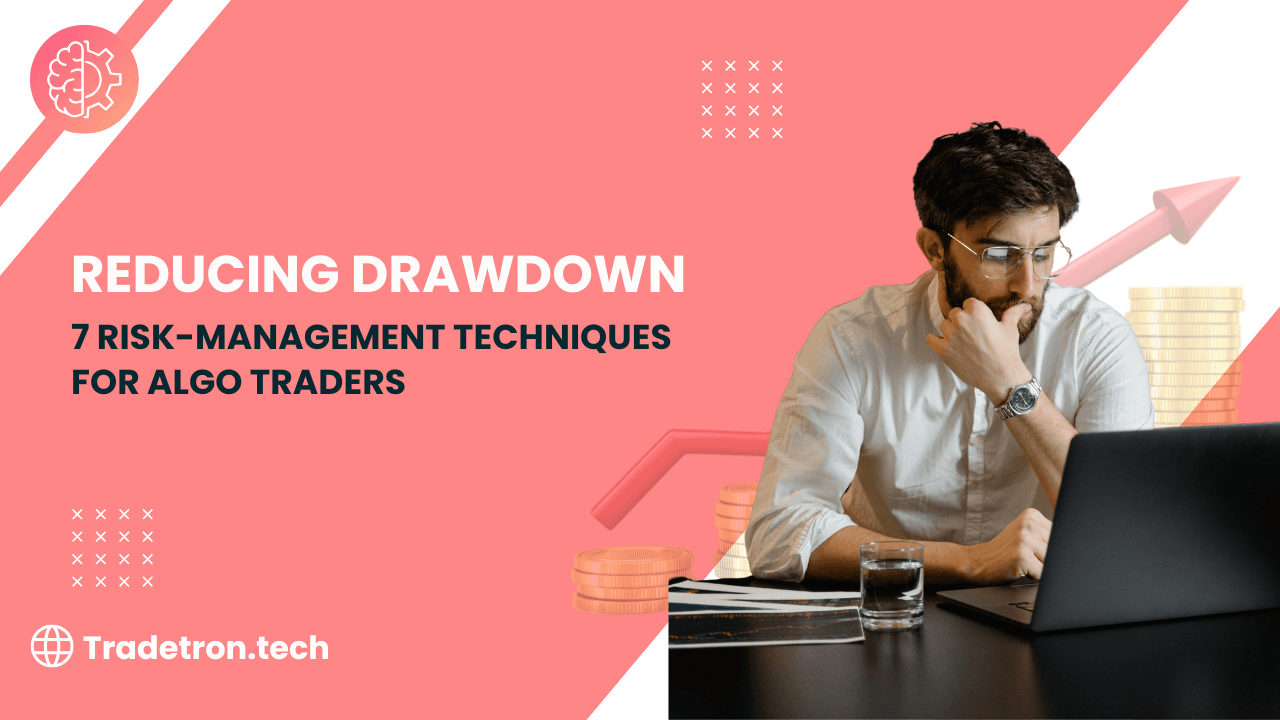
In the world of algorithmic trading, performance isn't just about maximizing returns—it's equally about minimizing losses. Drawdown, the measurement of decline from a peak to a trough in account value, represents one of the most critical metrics for trading sustainability. Even strategies with impressive overall returns can become impractical if the drawdown becomes too severe during adverse market conditions.
At Tradetron, we've observed that successful algo traders distinguish themselves not just by their profit-generating abilities, but by their systematic approach to risk management. Let's explore seven proven techniques for reducing drawdown that you can implement in your algorithmic trading strategies.
1. Position Sizing Optimization
Perhaps the most fundamental risk management technique is proper position sizing. Rather than allocating fixed capital amounts to each trade, consider these approaches:
Percentage-based sizing: Limit each position to a small percentage of your total capital (typically 1-3%). Tradetron's position sizing tools allow you to automatically calculate and implement these limits based on your risk tolerance.
Risk-based sizing: Size positions according to the specific risk of each trade. For instance, trades with wider stop-losses should have proportionally smaller position sizes. Tradetron enables you to define position sizes based on volatility metrics and stop-loss distances.
Volatility-adjusted sizing: Scale position sizes inversely to market volatility. During highly volatile periods, Tradetron can automatically reduce your exposure to maintain consistent risk levels.
2. Strategic Stop-Loss Implementation
Stop-losses are your first line of defense against catastrophic drawdowns, but their placement requires strategic consideration:
Technical stop-losses: Place stops at levels that invalidate your trading thesis, such as below key support levels for long positions. Tradetron's technical analysis tools help identify these critical levels.
Volatility-based stops: Set stop-losses based on a multiple of the asset's average true range (ATR) to adapt to changing market conditions. Tradetron's volatility calculators make this implementation seamless.
Time-based stops: Exit trades that haven't performed as expected within a predetermined timeframe. Tradetron's time-based exit conditions help prevent capital from being tied up in underperforming positions.
3. Correlation Analysis and Diversification
Trading multiple correlated instruments significantly increases drawdown risk. Tradetron's correlation analysis tools help you:
Monitor strategy correlations: Automatically calculate the correlation between your various trading strategies and instruments.
Balance your portfolio: Ensure your algorithms trade a mix of uncorrelated or negatively correlated assets.
Set exposure limits: Define maximum exposure limits for correlated asset groups, preventing overconcentration in similar market segments.
4. Adaptive Strategy Parameters
Markets evolve continuously, requiring your algorithms to adapt accordingly:
Dynamic parameter adjustment: Tradetron allows you to create algorithms that automatically adjust their parameters based on changing market conditions, including volatility regimes and trend strength.
Market regime filters: Implement filters that modify strategy behavior during different market regimes (trending, ranging, or volatile). This prevents algorithms from trading during unfavorable conditions.
Performance-based adjustments: Configure your strategies to automatically reduce position sizes after consecutive losses or increase them after confirmed profitability periods.
5. Circuit Breakers and Kill Switches
Implementing emergency protocols for extreme situations is essential:
Daily loss limits: Set maximum acceptable daily drawdown thresholds that automatically halt trading when breached. Tradetron's risk management dashboard allows you to monitor these limits in real-time.
Consecutive loss counters: Program your algorithms to pause trading after a specified number of consecutive losing trades, allowing for strategy reassessment.
Volatility circuit breakers: Configure automatic trading pauses during extreme market volatility events. Tradetron's volatility monitoring tools can detect these conditions and protect your capital.
6. Multi-Strategy Approach
Relying on a single strategy creates vulnerability to specific market conditions. Instead:
Deploy complementary strategies: Implement multiple algorithms with different underlying logic that perform well in different market environments.
Strategy rotation systems: Tradetron enables you to create meta-strategies that allocate capital dynamically between different algorithms based on their recent performance and current market conditions.
Hedging strategies: Develop algorithms specifically designed to hedge your primary strategies during adverse conditions. Tradetron's platform makes it easy to coordinate these complex interactions.
7. Rigorous Backtesting with Focus on Drawdown
Before deploying any algorithm, thorough validation is critical:
Stress testing: Tradetron's backtesting engine allows you to analyze how your strategies would have performed during historical market crashes and high-volatility periods.
Monte Carlo simulations: Generate thousands of potential performance scenarios to understand the range of possible drawdowns, not just the historical ones.
Walk-forward analysis: Test your strategies across multiple market periods to ensure consistent performance and manageable drawdowns across different conditions.
Implementing Risk Management with Tradetron
Tradetron's algo trading platform provides comprehensive tools for implementing all these risk management techniques:
Visual strategy builder for creating sophisticated risk management rules without coding
Real-time risk monitoring dashboards
Automated position sizing and capital allocation systems
Integrated correlation analysis tools
Historical and forward testing capabilities with detailed drawdown metrics
Strategy performance analytics focused on risk-adjusted returns
By implementing these 7 risk management techniques using Tradetron's platform, you can significantly reduce drawdowns while maintaining attractive returns. Remember that consistent profitability in algorithmic trading isn't just about finding profitable signals—it's about surviving and thriving through all market conditions.
Conclusion
Drawdown management represents the difference between long-term trading success and account-destroying losses. By implementing these 7 techniques through Tradetron's comprehensive algorithmic trading platform, you can create robust systems that generate returns while preserving capital during inevitable market downturns.
The most successful algo traders understand that protection against drawdown isn't just a defensive measure—it's an offensive strategy that allows for more aggressive position sizing and compounding over time.
Frequently Asked Questions
1: How does drawdown differ from normal trading losses?
While individual trading losses are inevitable, drawdown measures the cumulative decline from the peak account value to its lowest point. Excessive drawdown can lead to psychological challenges, margin calls, and the inability to recover. Tradetron's risk management tools help you monitor and manage both individual losses and overall drawdown.
2.What's considered an acceptable drawdown percentage for algorithmic trading?
Acceptable drawdown varies by strategy and risk tolerance, but many professional algo traders aim to keep maximum drawdown below 15-20% of account equity. Tradetron's performance analytics help you assess whether your strategy's drawdown aligns with industry benchmarks and your personal risk tolerance.
3. Can Tradetron automatically adjust my strategy during periods of high drawdown?
Yes, Tradetron enables you to create adaptive algorithms that respond to drawdown events. You can configure rules that automatically reduce position sizes, tighten stop-losses, or temporarily halt trading when drawdown reaches predefined thresholds.
4. How frequently should I review the drawdown metrics of my trading algorithms?
While Tradetron provides real-time monitoring, a structured weekly review of drawdown metrics is recommended for active strategies. Additionally, performing a comprehensive monthly analysis helps identify longer-term patterns and potential strategy degradation before they become significant problems.
5.Is it better to focus on reducing maximum drawdown or average drawdown?
Both metrics matter, but maximum drawdown often receives more attention because it represents the worst-case scenario that could threaten trading sustainability. Tradetron's analytics platform helps you monitor both metrics, allowing you to optimize your strategies for smoother equity curves with manageable peaks and troughs.



 Made with Superblog
Made with Superblog